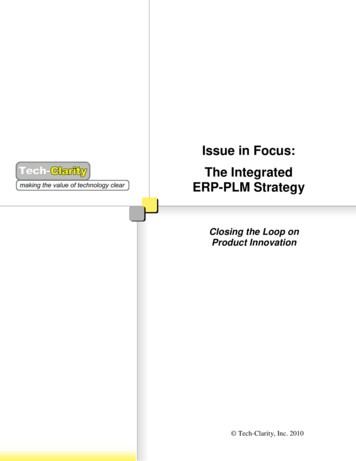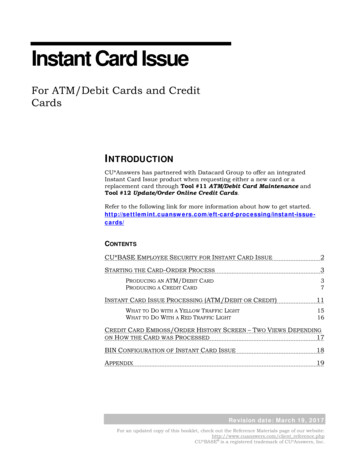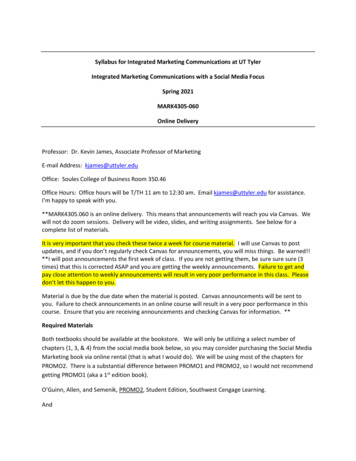
Transcription
Issue in Focus:The IntegratedERP-PLM StrategyClosing the Loop onProduct Innovation Tech-Clarity, Inc. 2010
Table of ContentsTable of Contents. 2Introducing the Issue. 3What to Expect from ERP . 4What to Expect from PLM . 4Closing the Loop on Product Innovation . 5Developing the ERP-PLM Strategy . 7Conclusion . 8Recommendations . 9About the Author . 92 Tech-Clarity, Inc. 2010
Introducing the IssueThe modern manufacturer relies on strong enterprise systems to stay competitive intoday’s global, challenging, and uncertain markets. Of all of the solutions thatmanufacturers employ, ERP and PLM are the primary systems driving productprofitability. As reported in Tech-Clarity research report “The Complementary Roles ofERP and PLM,” ERP and PLM play important, distinct, and complementary roles. Theintegration of these solutions has increased and advanced as manufacturers’ use of thesystems has matured. Combined, ERP and PLM can provide greater value, closing theloop on product lifecycles and product innovation. After all, a major product innovationsuch as introducing a new product can’t contribute any revenue if the enterprise can’texecute on sourcing, manufacturing, and selling it effectively. PLM’s role of innovationand ERP’s role of execution are not only complementary – they are dependent on eachother.Of all of the solutions that manufacturers employ, ERP and PLMare the primary systems driving product profitability.As clear as the lines between ERP and PLM have become, innovation is not limited toEngineering. While major new product developments typically come from Engineeringor R&D, Manufacturing and Service organizations frequently identify smallerinnovations that can improve quality or reduce total lifecycle costs. These day-to-dayinnovations, such as minor part revisions to improve manufacturing efficiency or makeproducts more robust, are frequently implemented in a disjointed way. For example,drawings may be manually marked on the shop floor or manufacturing bills of material(BOMs) may be changed in ERP independently from the engineering BOM. This leads todisconnects between Engineering and Manufacturing and prevents capturing theinnovation for future products.Manufacturers must develop a strategy to close the loopbetween Engineering and Manufacturingto get the most business value from innovation in all its forms.An integrated ERP-PLM strategy, on the other hand, provides the opportunity for a rapid,confident flow of innovation to and from Manufacturing. In today’s lean and competitivebusiness environment, companies can’t afford a disconnect. Manufacturers must developa strategy to close the loop between Engineering and Manufacturing to get the mostbusiness value from innovation in all its forms.3 Tech-Clarity, Inc. 2010
What to Expect from ERPMost manufacturers have learned what to expect from ERP. The integrated nature of ERPprovides a single view into manufacturing, sales, sourcing, and financial activity. Thiscentralized data helps companies plan effectively and make better business decisions. Inparticular, ERP has proven very valuable in helping manufacturers manage and controlthe complexities of business in today’s global, fast-paced markets. ERP helps companiescontrol cost, manage operations, and balance supply with demand to ensure they deliveron customer expectations, and do so in a profitable way. Most manufacturers today areusing some form of ERP system to manage their business. In essence, ERP’s role isexecuting the business of manufacturing (see Figure 1).ERP has proven very valuable in helping manufacturers manage and controlthe complexities of business in today’s global, fast-paced markets.Figure 1: Manufacturing Systems EcosystemERP’s role is executing the business of manufacturing.4 Tech-Clarity, Inc. 2010
What to Expect from PLMPLM offers complementary, distinctly different value than ERP. As more companies areadopting PLM, it’s important to understand what PLM can offer and how it fits withERP. While ERP focuses on execution, PLM focuses on product innovation. PLM isdesigned to help manufacturers design, develop, and launch profitable products. The corecapabilities of PLM include data management and engineering change control, but moreadvanced capabilities include configuration management, project management, designcollaboration, and more. The most advanced PLM solutions also include strategiccapabilities such as environmental product compliance, manufacturing process planning,and quality planning.While ERP focuses on execution,PLM focuses on product innovation.Of course most manufacturers aren’t able to implement all of these capabilities at once,but instead take a “PLM Program” approach to put in the basics and grow from there. AsTech-Clarity’s “The PLM Program - An Incremental Approach to the Strategic Value ofPLM” advises, however, manufacturers should be careful to select a solution and partnerthat they can grow with as they mature in their adoption of PLM.PLM is designed to help manufacturers design, develop,and launch profitable products.While ERP focuses primarily on control and cost management, PLM benefits includetop-line drivers such as more innovative products and rapid new product introduction. Ofcourse PLM also helps reduce product and product development costs, impacting boththe top and the bottom line. Perhaps one of the most important benefits that PLM offers isfostering better communication and collaboration between Engineering, Manufacturing,Sourcing, Service, and other departments to improve product innovation and developproducts right the first time. Integrating PLM with ERP helps strengthen and expand thatcross-departmental cooperation.Closing the Loop on Product InnovationWith that background on ERP and PLM and the individual roles they play, let’s turn tothe increased value they offer in a closed-loop, integrated manufacturing system. Today,companies are running lean in order to survive the economy. Product innovation slowedduring the down period for many companies, and as Tech-Clarity’s “Innovating Throughan Economic Downturn” paper points out many companies shifted innovation focus tominor enhancements and cost reduction. But forward-thinking manufacturers recognizedthe need to focus on strategic innovation to take advantage of the recovery.5 Tech-Clarity, Inc. 2010
Now, as the early recovery is unfolding, manufacturers realize that speed and agility arethe keys to taking advantage of new opportunities. Manufacturers who are able to rapidlyrespond to market demand and launch new products will fair much better in the recovery.Manufacturers who are able to rapidly respond to market demand and launchnew products will fair much better in the recovery.As many found out during the down times, it was also very valuable to be able tointroduce cost reductions and cosmetic enhancements to keep customers interested on anongoing basis. The time to market for these changes includes the time to develop a newproduct or engineering change plus the time to release to manufacturing and scale upproduction. As cost improvement and quality efforts are put in place, getting thoseimplemented in the plant and supply chain rapidly is a competitive advantage. Closingthe loop means that lessons learned in manufacturing and service are fed back toengineers to design quality and cost improvements into products.Closing the loop means that lessons learnedin manufacturing and service are fed back to engineersto design quality and cost improvements into products.Unfortunately, rapid introduction of continuous improvements is usually held backbecause companies lack confidence in their ability to implement the changes withoutmajor disruption, and are worried they will create bigger problems by introducingfrequent changes that will get lost or poorly communicated. Companies can’t afford toget changes wrong and are more likely to introduce them slowly, or batch togethermultiple changes. On the other hand, those manufacturers that have the confidence torespond to downstream feedback and rapidly introduce changes to manufacturing are atan advantage.Rapid introduction of continuous improvements is usually held backbecause companies lack confidence in their ability to implement the changeswithout major disruption A well controlled, integrated product lifecycle allows manufacturers to have theconfidence to introduce more rapid product innovation of all sizes. It also helps leanorganizations that can’t afford the waste of inefficient release to manufacturing or poorchange control which can result in wasted time and effort, but also BOM errors, buildingor buying to wrong revisions, and creating scrap and rework. A synchronized ERP andPLM environment helps build the required confidence as well as streamline processes forefficiency.6 Tech-Clarity, Inc. 2010
Developing the ERP-PLM StrategyAs manufacturers realize they need both ERP and PLM, it is important to address thesolutions strategically. Companies must proactively identify the needs for productinnovation and execution. They should focus on the needs of the business first, beforetechnology needs. ERP and PLM strategies are too important to be technology-leddecisions, and should be addressed in a process-centric approach.ERP and PLM strategies are too important to be technology-led decisions,and should be addressed in a process-centric approach.After requirements are identified, it is time to search for solutions. Manufacturerssearching for ERP or PLM should take into account their general needs, as well as uniqueindustry requirements. They should also recognize needs driven by their manufacturingmodel. For example, an engineer to order (ETO) company has different requirements forERP and PLM than a make to order (MTO) business. Of course no software solutionmeets every possible need, so manufacturers should also look for solutions that providethe flexibility and tailorability needed to make the solution work for them.Recognizing that both ERP and PLM are critical to product profitability,manufacturers must be uncompromising on the needs of these two systems.Recognizing that both ERP and PLM are critical to product profitability, manufacturersmust be uncompromising on the needs of these two systems. The odds of finding a singleERP-PLM solution that meets ERP and PLM needs for their industry, theirmanufacturing model, and their business are very small. Most companies will need toadopt a best-of-breed strategy.Once candidate ERP and PLM solutions are identified, manufacturers then need toconsider integration. As Tech-Clarity’s “The Evolving Roles of ERP and PLM:Integrating the Roles of Execution and Innovation” report reported, most manufacturersstart small and then mature their integration over time. Event-driven integration includingrelease to manufacturing and engineering change management processes are a good placeto start. Further integration can provide visibility from shop floor to design informationand 3D models, provide cost and supplier data back to Engineering, and then expand overtime. Even more advanced integration includes bi-directional information flow andpotentially composite applications where data from both systems is combined inworkflows, dashboards, and portals. As system use and integration mature, somecompanies go beyond the basics of release to manufacturing and change control toinclude information like manufacturing processes (bill of process) and quality plans.7 Tech-Clarity, Inc. 2010
The good news is that integration has gotten much easier from a technicalperspective, and is now safe to consider as a lower priority selection criteria.The good news is that integration has gotten much easier from a technical perspective,and is now safe to consider as a lower priority selection criteria. Be aware that there aredifferent integration approaches, look for one that meets your level of maturity in bothprocesses and IT infrastructure. The key is to first find the best solutions for innovationand execution, and then look for integration. ERP and PLM vendors that have the rightsolutions for your business and have partnered to take on the role of integrating thesolutions are likely a good option. These companies have proactively worked out thesemantic differences and process flows between their solutions, and built technicalinfrastructure to assist manufacturers’ efforts. They have typically also addressedcapabilities such as closed loop transaction management and exception handling in theirintegration – features too commonly overlooked in custom integration efforts. Preintegrated solutions can provide a significant boost to fulfilling the closed loop ERP-PLMstrategy.ConclusionERP and PLM offer distinct, unique value. Together, ERP and PLM offer even greaterbusiness value. Manufacturers today need to innovate rapidly, and execute confidently oninnovations big and small. Closing the loop between innovation and execution helpsdrive more rapid time to market, reduce cost, and improve quality. Having the right PLMand ERP solutions to enable strong innovation and execution is crucial to productprofitability. Integrating the solutions extends the value of each, giving manufacturers theability to rapidly innovate and the confidence to speed that innovation to market where itcan provide new business value.ERP and PLM offer distinct, unique value.Together, ERP and PLM offer even greater business value.8 Tech-Clarity, Inc. 2010
RecommendationsBased on industry experience and research for this report, Tech-Clarity offers thefollowing recommendations to: Choose the right ERP and PLM solutions, making sure they meet your company,industry, and manufacturing model requirements.Close the loop on product innovation by integrating ERP and PLM.To enable product innovation and execution, look for (in order of priority):o Solutions that enable each of the functions.o Integration-capable ERP and PLM solutions, for example those thatemploy technology such as API, SOA, and XML.o Pre-integrated solutions where the vendors have worked out the semantics,data models, and workflows between the systems.About the AuthorJim Brown is the President of Tech-Clarity, an independent research and consulting firmthat specializes in analyzing the true business value of software technology and services.Jim has over 20 years of experience in software for the manufacturing industries, with abroad background including roles in industry, management consulting, the softwareindustry, and research. His experience spans enterprise applications including PLM, ERP,quality management, service, manufacturing, and others. Jim is passionate aboutimproving product innovation, product development, and engineering performancethrough the use of software technology and social computing techniques.Jim is an experienced researcher, author, and public speaker and enjoys the opportunityto speak at conferences or anywhere that he can engage with people that are passionateabout improving business performance through software technology.Jim can be reached at jim.brown@tech-clarity.com, or you can find him on Twitter at@jim techclarity or read his blog at www.tech-clarity.com/ClarityonPLM.9 Tech-Clarity, Inc. 2010
ERP-PLM solution that meets ERP and PLM needs for their industry, their manufacturing model, and their business are very small. Most companies will need to adopt a best-of-breed strategy. Once candidate ERP and PLM solutions are identified, manufacturers then need to consider integration. As Tech-Clarity's "The Evolving Roles of ERP and PLM:











